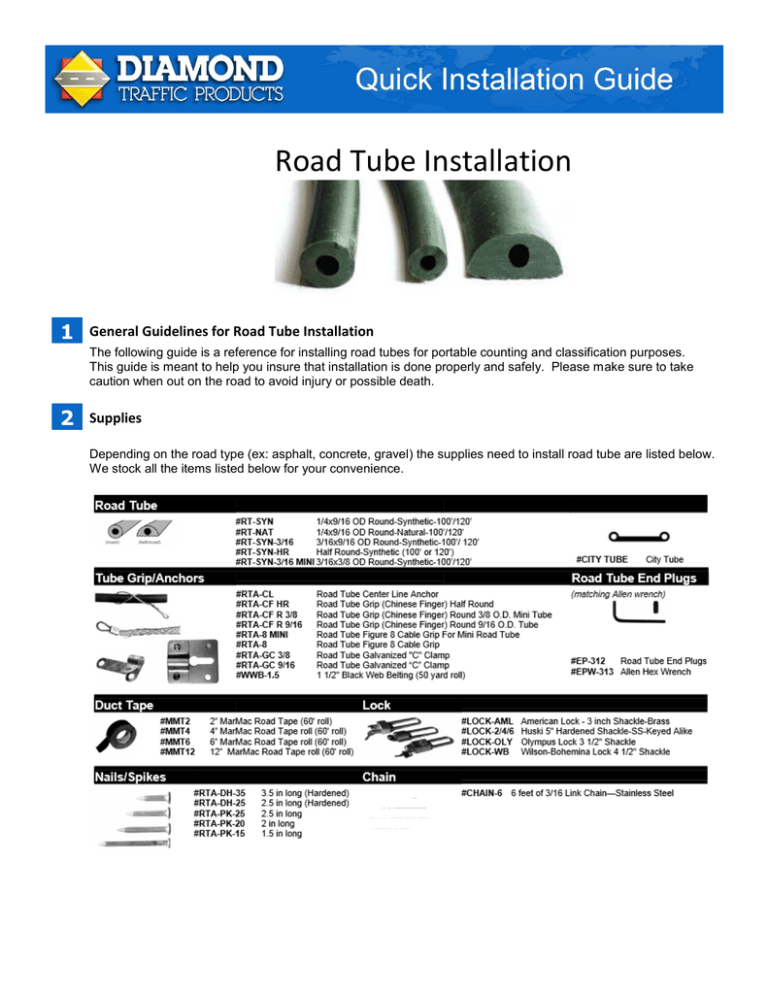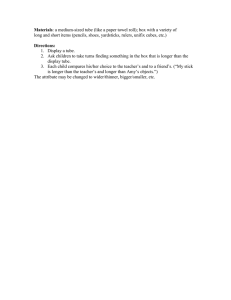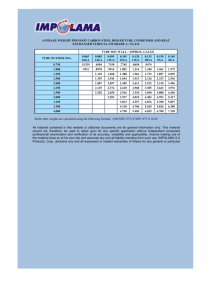
Road Tube Installation
1
General Guidelines for Road Tube Installation
The following guide is a reference for installing road tubes for portable counting and classification purposes.
This guide is meant to help you insure that installation is done properly and safely. Please make sure to take
caution when out on the road to avoid injury or possible death.
2
Supplies
Depending on the road type (ex: asphalt, concrete, gravel) the supplies need to install road tube are listed below.
We stock all the items listed below for your convenience.
Version 1.1 9/10/2013
A
Road Tube Quick Installation Guide
Selecting Road Tube
Proper selection of Road Tube can extend the life of your tube, improve data accuracy and prevent damage to your
counter unit. Always use tubing that is designed for vehicle counting. There are two main types of rubber tube
available. The table (table 1) below shows their properties and suggested applications.
Diamond Traffic Products, Inc.
Copyright © 1991-2013 All Rights Reserved
Page 2
Version 1.1 9/10/2013
B
Road Tube Quick Installation Guide
Checking Road Tubes before Placement
Road Tube Condition:
Road tubes can have holes or cuts in them from previous use. Bend the road tube continuously for the
entire length and look for small cracks that indicate that the tube is getting old and may to provide poor
results. Check the tube for holes at 2 PSI (maximum) of air pressure with the tube submersed in water. If
there are any bubbles, then the tube has a hole or crack. One or two small holes may be usable, however it
is a sign of a tube that will eventually fail. In wet conditions holes in the tube will draw in water that can
block air signal to the counter. A small amount (ex: one tablespoon) of water can stop the pulse from
reaching the counter and possibly damage the airswitch in the counter.
Road Tube Obstructions:
Dirt and insects can get into the tube; clear these out with compressed air. To remove water before use
(if you don’t have access to compressed air) start from the far end of the tube and raise it to chest height
then slowly walk the length of the tube causing each section to be raised to evacuate any water.
Road Tube Length:
Keep the length of the road tube no shorter than 30 feet and no longer than 100 feet. The ideal length is
40 to 60 feet. Road tubes shorter than 30 feet will damage the air switches very quickly. Lengths longer
than 60 feet will start to miss some axle hits that occur beyond 60 feet.
Make sure that tubes used for classification are the same length. If they are more than 6 inches in
difference, you need to cut them to be equal length. When stretching tubes used for speed or axle
classification take care to stretch both tubes the same amount.
Insert End Plugs:
The end of the road tube that is not connected to the counter should have a plug in it to keep out water,
dirt and insects to allow the air switch to function properly. A concrete nail will work temporarily, however
they will work themselves out of the tube over time. Also the threaded end plugs will work out unless
inserted about 1 1/4" inches into road tube. To absolutely stop them from working out, use bailing wire and
place a couple wraps around tube between end of plug and the end of the tube.
C
Selecting You Count Site Location
Location: Choose a spot preferably on a straight, flat roadway with free flowing traffic between 10mph and
70+mph. Diamond air switches will work consistently down to 6mph and to over 100mph and beyond.
Speed Consideration: Vehicles traveling faster than 70mph especially trucks will cause the road tube to slap
or bounce excessively on the road surface. At speeds in excess of 60mph we highly recommend taping the
road tube every 10 feet to the road to prevent road tube bounce.
Road Surface Condition: Avoid rutted and potholed roads. They cause the road tube to slap and could cause
the counter to double count. Consider the quality of pavement you are driving nails into, if it is poor, then your
nails or tape may not stay in place for the duration of your study.
Problem Locations: Stay away from traffic signals and other places where cars are likely to stop, drastically
slow down or speed up. If you count the legs of an intersection, counting the outbound lanes will work better.
Diamond Traffic Products, Inc.
Copyright © 1991-2013 All Rights Reserved
Page 3
Version 1.1 9/10/2013
Road Tube Quick Installation Guide
If you must count the inbound lanes, place road tubes where traffic is moving at least 7 mph (ex: midblock
placement). Likewise, hills and off ramps can be counted, but take precautions to prevent the tube from being
rolled or pulled down the road causing tears in the tube and inaccuracy in speed calculations. Use road tape to
secure the tube in each lane to the road surface for best results.
D
Road Tube Installation
Road tube is held into position on the road by a wide variety of fixtures. Most are
designed to attach the road tube at the edges of the road. On very wide roads centerline
clamps are used or the tube can be taped to the road in the center. Most securing
devices attach to asphalt/concrete with concrete nails. The nail is driven into the asphalt
until the nail head sticks up ¼” above the pavement. Most securing hardware is
designed to slip over the nail head and is held in position by the tension of the road tube.
In hot weather (90 degrees and above) we recommend, where possible, that you drive
12” spikes into the dirt alongside the road.
STEP #1 Install Anchor on the Far End (opposite side of the road).
Use a small sledge hammer to place your nail in the pavement. Measure out the
distance between tubes if you are installing more than one tube and place your
other nail/anchor appropriately.
STEP #2 Layout Tube Across Roadway:
After Attaching your road tube grip and securing your end plug, walk your tube
across the roadway and secure it with your anchor. After it is secure, return to
the near side to place your anchor in the pavement.
NOTE: Do not hold onto a road tube when a vehicle drives
over it. Occasionally a vehicle can “grab” the tube pulling it
and all of the metal attached to it right out of your hand(s).
STEP #3 Install Near Side Anchor:
Check to make sure your tube will lay perpendicular to the road and then place
your nail/anchor. Attach the road tube to the anchor using your grip.
STEP #4 Stretch Tube:
To tighten the tube, stretch your tube about 10 to 20% to be taut. If the roadway
has ruts, potholes or will not stay in place, mastic or heavy tape will be needed
to ensure that the tube does not move or detach during the study. If your roadway
width is greater than 50ft, proceed to step 5 otherwise proceed to step 6.
Diamond Traffic Products, Inc.
Copyright © 1991-2013 All Rights Reserved
Page 4
Version 1.1 9/10/2013
Road Tube Quick Installation Guide
NOTE: For Traffic traveling faster than 55MPH, securing the
road tube with tape is recommended at least every 10ft.
STEP #5 Install Center Line anchors (if needed):
Install the center line anchor(s) on the center line of the road using nails or
concrete screws and secure the tube at the center line location after it is taut.
These should be out tire travel paths as to not be normally run over by traffic. Be
extra careful in the roadway and avoid traffic. Ideally, a second person is used
to spot traffic. In a busy roadway, additional flagging may be necessary. Be safe!
STEP #6 Attach Tube to Counter:
Make sure you have at least 10ft of tube between your anchor point and the
traffic counter. You can coil any slack tube around or near the counter. Connect
the open tube end to the appropriate nozzle on the counter making sure it is
securely fastened to the nozzle. If you are installing more than one tube,
measure out the distance between tubes (identical to step #1) and Repeat steps
2-6 for each tube your are installing.
E
Common Road Tube Configurations
Diamond Traffic Products, Inc.
Copyright © 1991-2013 All Rights Reserved
Page 5
Version 1.1 9/10/2013
F
Road Tube Quick Installation Guide
Troubleshooting
Diamond Traffic Products, Inc.
Copyright © 1991-2013 All Rights Reserved
Page 6
Version 1.1 9/10/2013
Road Tube Quick Installation Guide
Testing Road Tube Air Signal:
Testing the road tube for proper signal is recommended if you suspect a tube
failure. Using a tube tester such as the model 1110 (pictured right) can simplify
the task and give you an accurate assessment. If you do not have a tester,
you can use the counter to verify the tube is operating by using the display or
monitor function. It is not recommended to manually test tubes (DO NOT insert
the tube into your ear or mouth for any reason at any time).
If you have all your road tubes installed and connected to the counter you are ready to test
for proper operation. Turn the counter “on” and press the key that will bring up “configure
system” (see instruction on inside of lid for a listing.) Press the enter key when display
shows configure system. If you are going to do time interval count with no speed or axle
data collection, select “count” from the choices of “raw”, “binned”, “count” or “sensor”. Then
press the enter key until you are back to configure system. If you need binned, speed or axle data, select “binned”
and press enter until “configure system” shows on screen.
From “configure system” press “1” key to get “starting collecting”. Step through the program and verify proper operation.
In count only you will know if the road tubes are registering properly. If classifier is set to speed and axle classify and
Diamond Traffic Products, Inc.
Copyright © 1991-2013 All Rights Reserved
Page 7
Version 1.1 9/10/2013
Road Tube Quick Installation Guide
you get questionable results or a lot of sensor miss codes check for proper road tube operation by reprogramming the
counter to operate in count only and set it to count every axle and not divide by two. Then verify that each road tube
counts the correct number of axles and that they show up in the correct channel of the counter. Do this in “test sensor”
mode located almost at the end of the programming setup for count. In test sensor you can zero the count on the
display after each vehicle passes by pressing the “0” key. That will eliminate the need to add and subtract axle
numbers in your head.
Four pound sledge hammer
Gloves
Pry bar to remove nails
Duct Tape
Six foot lengths of chain
Tape measure
Padlock(s)
Safety vest and hat
Road tube end plug(s)
2 ½ “and 3 ½” concrete
nails
12” dirt spikes
Your favorite road tube
grips and anchors
Road tube(s) and traffic
counter(s)
It is available in 3/8” outside diameter with a 3/16” inside diameter and also in 9/16” outside diameter and either 3/16”
or 1/4" inside diameter. We recommend that you use the 1/4" inside diameter with the 9/16 O.D.
The road tube needs to be secured to the road at the edges of the road. If the distance between securing devices
is over 50 feet you should have a securing device in the middle to keep the tube from bowing or drifting at the
center. Also for traffic over 60 mph we recommend taping tube every 10 feet if you are speed or axle classifying.
Pre-placement of securing hardware on the road tube at the approximate location will make installation on
roadway safer and quicker.
We recommend that you secure the end of tube opposite the counter first. Take required number of nails plus
spares, a hammer and your tube to the far side of the road and drive the nails into the asphalt, concrete, or dirt.
Hook your securing hardware that you pre-attached to the end of the road tube over the nail’s head (shown at
the right). When you have plenty of space between traffic, lay out the road tube across traffic lane or lanes.
When installing Road Tubes for classification, measure the tube spacing at both ends to ensure accurate
classification.
Do not hold onto a road tube when a car drives over it. Occasionally a vehicle can “grab” the tube pulling it and
all of the metal attached to it right out of your hands.
Make sure that you stretch the road tubes about 10-20% to keep it tight to the road. If you are having trouble
keeping road tube where you want it duct tape will help.
Plug the tube into the counter.
Type
Natural
(Isoprene)
Properties
Stays flexible at colder temp (freezing). Very Strong.
Application
Cold climates.
Synthetic
(EPDM)
A synthetic/natural blend. Resistant to UV rays, less stretch
then natural.
Hot and moderate climates, long term
road installations.
Mini Tube
Smaller, Lighter weight, comes in synthetic and natural. 3/16in
size.
Same as standard size applications.
Diamond Traffic Products, Inc.
Copyright © 1991-2013 All Rights Reserved
Page 8





